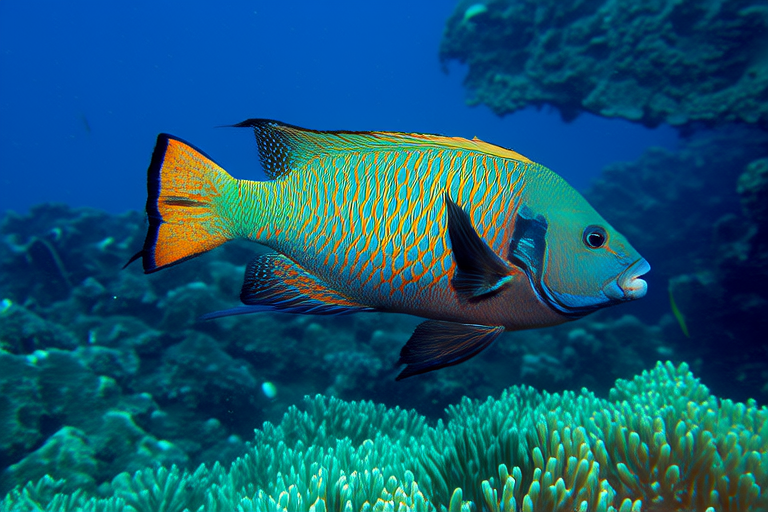Top 10 Fascinating Facts About the Colorful Parrot Fish
The parrot fish is one of the most colorful and fascinating creatures that inhabit the tropical and subtropical waters around the world. These fish are known for their vibrant colors, unusual behaviors, and significant role in maintaining the health of coral reefs. This article will delve into ten of the most fascinating facts about parrot fish, exploring their unique characteristics, behaviors, and ecological importance.
1. Vibrant Color Changes with Age and Mood
Parrot fish are renowned for their stunning and diverse array of colors. As they age, their appearance can change dramatically, reflecting both their maturity and mood. Juvenile parrot fish often have more subdued colors, which evolve into bright hues as they grow older. The males, in particular, display a striking palette of blues, greens, reds, and yellows during mating season. This color transformation is not just for show; it serves as a vital communication tool, signaling readiness to mate or alerting other fish of potential danger.
2. Guardians of Coral Reefs
Parrot fish play a crucial role in maintaining the health of coral reefs, acting as nature’s gardeners. They feed on algae that can overgrow and smother corals, thereby ensuring that the corals receive adequate sunlight for photosynthesis. Their diet consists mainly of coral polyps and algae, which they scrape off the reef surface using their strong beaks. This activity helps in keeping the coral reefs clean and healthy, contributing significantly to the overall biodiversity of these underwater ecosystems.
3. Unique Sleeping Habits
One of the most peculiar behaviors of parrot fish is their sleeping routine. Before retiring for the night, these fish secrete a mucous cocoon from glands near their gills. This cocoon acts as a protective barrier, masking their scent and potentially deterring predators. It’s believed that this mucus also contains chemicals that can neutralize the sense of smell of potential nocturnal hunters. This behavior underscores the adaptability and resourcefulness of parrot fish in their natural habitat.
4. Feeding Behaviors: The Power of Their Beaks
The feeding habits of parrot fish are as fascinating as their coloration. Equipped with powerful beaks, these fish can break apart coral and rock with ease, extracting the algae and coral polyps that make up their diet. Some species even have specialized teeth arranged in rows that resemble a parrot’s beak, hence their name. This feeding method not only sustains the parrot fish but also contributes to the recycling of calcium carbonate within the reef system, which is essential for the growth and maintenance of coral structures.
5. Defensive Mechanisms: Camouflage and Speed
In addition to their protective mucus cocoons, parrot fish possess other defensive strategies. Many species have the ability to change their color rapidly, allowing them to blend into their surroundings and avoid detection by predators. Their vibrant colors can also serve as a warning sign to potential threats. Furthermore, parrot fish are swift swimmers, capable of darting away from danger at impressive speeds. These adaptations help them survive in the dynamic and sometimes perilous environment of the ocean.
6. Reproduction: Mating Rituals and Nest Building
The reproductive process of parrot fish is an elaborate affair, involving intricate mating rituals. During the breeding season, male parrot fish construct large nests from sand, which they meticulously groom to attract females. Once a female selects a nest, she deposits her eggs inside, where they are then fertilized by the male. This process not only ensures the survival of the species but also highlights the complex social behaviors of these fish.
7. Scientific Discoveries: Insights into Coral Reef Health
Recent scientific studies have provided valuable insights into the relationship between parrot fish and coral reef health. Research has shown that areas with higher populations of parrot fish tend to have healthier and more resilient coral reefs. This finding underscores the importance of protecting parrot fish populations and their habitats. Scientists are also exploring the potential use of parrot fish behavior patterns as indicators of environmental stress in coral reefs, offering a new approach to monitoring reef health.
8. Conservation Status: Threats and Protection Efforts
Despite their importance to marine ecosystems, parrot fish face numerous threats, including overfishing and habitat destruction. Many species are considered vulnerable or endangered due to unsustainable fishing practices. Conservation efforts are underway to protect parrot fish populations and their habitats. Marine protected areas and sustainable fishing regulations are being implemented to ensure the long-term survival of these remarkable creatures. Public awareness campaigns also play a crucial role in educating communities about the significance of parrot fish and encouraging responsible stewardship of marine resources.
9. Cultural Significance: Symbolism and Art
Parrot fish hold cultural significance in many coastal communities around the world. In some Polynesian cultures, they are revered as symbols of fertility and prosperity. Their vibrant colors and unique behaviors have inspired artists and craftspeople, who incorporate parrot fish motifs into jewelry, textiles, and decorative arts. This cultural connection highlights the deep appreciation that many societies have for these fish and underscores the importance of preserving their natural habitats.
10. Adaptations to Oceanic Life
Parrot fish have evolved several adaptations that allow them to thrive in the challenging conditions of the ocean. Their streamlined bodies and strong fins enable efficient swimming, while their tough scales provide protection against predators. Additionally, their gills are specially adapted to extract oxygen from seawater, even in low-oxygen environments. These adaptations demonstrate the remarkable resilience and adaptability of parrot fish, enabling them to survive and flourish in the vast and varied oceanic ecosystem.
In conclusion, parrot fish are not only visually captivating but also ecologically important. Their vibrant colors, unique behaviors, and critical role in coral reef health make them one of the most fascinating creatures in the marine world. By understanding and appreciating these remarkable fish, we can work towards preserving their habitats and ensuring the continued health and diversity of our oceans.
